Bushfire continues to burn out of control on Fraser Island after six weeks
The ABC reported that a bushfire has scorched a third of the World Heritage Area of Queensland’s idyllic Fraser Island, six weeks after being sparked by an illegal campfire.
Firefighters have been working to contain the blaze that broke out on October 14, which has ravaged tens of thousands of hectares of national park.
Fraser Coast Mayor George Seymour said the blaze was “the biggest one in living memory”.
“It’s been slowly burning since then and now it’s covered a third of the island, which is horrific to think about,” Cr Seymour said.
“Forest fires aren’t unusual on Fraser Island – this is just the biggest one in living memory.”

Brisbane resident Kristen Wessling is staying at the Kingfisher Bay Resort on Fraser Island and said it was intense earlier in the week.
“We went to Lake McKenzie on Monday and you could see ash falling while we were swimming in the lake, so it was a bit weird,” she said.
“Conditions were quite bad on Monday with the northerly blowing, so in Kingfisher Bay the effects of the fire were quite strong.
“On Sunday night on the jetty at Kingfisher, you could see the fire at night – it looked close but it was really, really far away.
The Department of Environment and Science (DES) said Wednesday’s milder temperatures and a wind change had improved conditions for firefighters.
In a statement, the DES said the strong northerly winds that had been pushing the main fire front further south had abated in favour of a southerly change, which had given firefighters an opportunity to build and strengthen containment lines.
A DES spokesperson said the bushfire was not threatening life or property and had not damaged any infrastructure.
Cr Seymour said he visited the island yesterday and said the smoke and visibility were “shocking”.
“It’s bad for young children and it’s very bad for elderly people, people with asthmatic conditions,” he said.
“The state government has dumped over half-a-million litres of water and gel on it, but what we need is rain.”

Cheryl Bryant from Save Fraser Island Dingoes Incorporated said the bushfire could devastate the local ecosystem and wildlife.
“Our concern is the long-term effects of what’s happening on the island – we’ve lost at least 30 per cent of the island now and it’s still burning,” Ms Bryant said.
“The smaller mammals can’t avoid the fires and there are so many vulnerable animals and many of them have perished.”

Short-term health issues surged after horrific bushfire season

The New Daily reported that last summer’s horrific bushfire season saw the rates of emergency visits for respiratory problems and sales of asthma medication skyrocket, a new report has found.
It comes as the Therapeutic Goods Administration says it is preparing for this year’s season, working to ensure Australia’s medical stockpile can keep up with the demand.
The report, Australian bushfires 2019-2020: Exploring the short-term health impacts, looked at the impacts of the poor air quality on health.
Australians need no reminding of the thick haze that covered most of the continent last summer. Its health effects are still concerning experts.
In some regions, visits to the emergency departments almost doubled, the Australian Institute of Health and Welfare report found.

“Some areas of New South Wales were affected more than others, with emergency department visits rising by more than 50 per cent in the Capital Region, during times of peak bushfire activity, and 86 per cent in the Riverina region,” AIHW spokesperson Richard Juckes said.
“The bushfire season of 2019-2020 saw widespread destruction of land, national parks and property, and tragically 33 people lost their lives.”
The smoke-related health costs of the 2019-2020 bushfire season have been estimated to be $1.95 billion, and the long-lasting effects are still unclear.
Never-before-seen peaks
Research shows some places had it worse than others.
Canberra residents experienced the worst air quality in the Territory’s history, and on some days, the worst recorded air quality in the world.
“In the week beginning January 5, hourly PM2.5 concentrations at the Canberra-based Florey air quality monitoring station reached 2,49m3 – hourly readings of 300 and above are considered ‘extremely poor’,” Mr Juckes said.
Analysis of pharmaceutical sales data shows with the smoke came asthma – with sales of medication increasing substantially.

In NSW’s Coffs Harbour–Grafton region, there were sales increases of 70 per cent for inhalers to help with shortness of breath for the week beginning November 10.
There was clearly little improvement in the following week, with sales staying 43 per cent above usual levels.
In the Capital Region in the week beginning December 29, there was a 63 per cent increase.
Brian Oliver leads the Respiratory Molecular Pathogenesis Group at the University of Technology Sydney. He said the increase in the sale of inhalers was surprising.
“One surprising feature highlighted by the report was the increased sales of inhalers, which are used to manage shortness of breath,” Professor Oliver said.
“The report did not examine who was buying these inhalers: Was this people with pre-existing lung diseases buying life-saving medications, or was this people panic-buying, as we have seen with COVID-19?”
The season ahead
The TGA has sought to assure Australians there is enough in the medical stockpiles to get us through another season of respiratory-related disorders, should we face more bushfires.
“There is currently no national shortage of salbutamol products, which includes metered-dose inhalers (puffers), dry powder inhalers and nebulisers,” a TGA spokesperson told TND.
Significant grass and vegetation growth and above-average temperatures have created the potential for a devastating fire season across southern parts of Australia this year.
Australians are being urged to prepare for a season of punishing bushfires and damaging rains.
Emergency Management Minister David Littleproud is urging people to fortify their defences in case of disasters over summer.
“While we can work with authorities to properly prepare, it’s also critical families, households and individuals do what they can to prepare themselves,” he said on Friday.

“By planning ahead, people can reduce the risk of injury and damage to property.”
The AIHW report, released on Wednesday, further found the bushfires didn’t just affect our physical health.
Mr Juckes said there were almost 19,000 bushfire-related Medicare subsidised mental health services accessed by 5094 patients.
Some 46 per cent of those services were delivered through a registered psychologist.
Black Summer bushfire health impact revealed in new report
The Canberra Times reported every day for months, Kirsten Connor started her day the same way.
“My morning routine was I would wake up and check the air quality app, the Fires Near Me app and get up and lay out my asthma medications for the day. It was a bit of a ritual,” Ms Connor said.
As smoke haze from bushfires near Braidwood and the South Coast choked Canberra for weeks on end, the Kaleen resident spent most of the summer inside her home, trying to avoid the hazardous health conditions outside.

In all of the years since she was first diagnosed as being asthmatic, Ms Connor said she had never experienced conditions as bad as those in the ACT during the Black Summer fires, where air quality in the ACT was at one point the worst in the world.
“It was the worst period of time to have to deal with asthma,” she said.
“It was a case of making sure everything was closed and keeping the air con and air filters on. If I did have to leave the house, I had to make sure I dosed myself with ventolin and take my preventer puffer.”
Those living with asthma and other respiratory illnesses were among the hardest hit by the weather conditions generated by the summer’s bushfires. Now a new report has confirmed the toll the smoke haze and bushfires had on people’s health.
The report, released by the Australian Institute of Health and Welfare, revealed a surge in presentations to emergency departments for respiratory conditions, along with a surge in medication issued to treat asthma.
While the report examined the short-term effects of the bushfires on people’s health, medical experts have said it could still be years before the full extent of health issues becomes clear.
Hospital presentations for respiratory diseases along the South Coast and Braidwood areas at the height of the bushfire crisis in those areas increased by 50 per cent between December 29 and January 5, compared with the same time the year before.
Across the whole of NSW, emergency presentations were also up by more than 50 per cent during December and early January.
Women were more likely to have been admitted to emergency for asthma and respiratory conditions compared with men at the peak of the bushfires.
The report also found sales of inhalers in the ACT surged dramatically during the height of the bushfires.
Between January 5 and 11, when the air quality in Canberra during the summer was at its worst, sales of inhalers jumped by 204 per cent compared to the same time in 2019.
From the week of December 8 until January 18, sales were more than 75 per cent above levels from the year before.
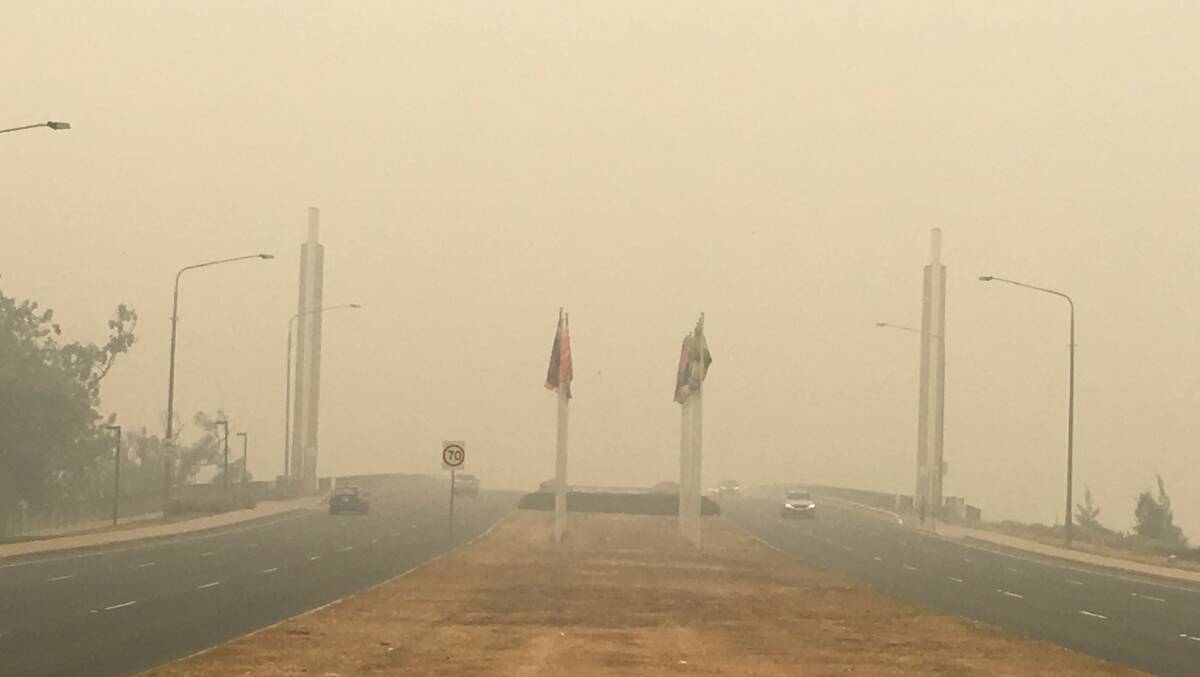
Commonweath Avenue bridge engulfed in smoke during the summer. Picture: Peter Brewer
A similar situation was seen for respiratory medication issued through the Pharmaceutical Benefits Scheme, where rates increased by as much as 80 per cent in Canberra, which triggered shortages at many ACT-based pharmacies.
READ MORE:
- Study on long-term impacts of bushfire smoke
- Canberra’s bushfire smoke made asthma worse, responsible for deaths: report
- Air quality data shows unprecedented levels of Canberra’s poor air quality
Marg Gordon from the National Asthma Council of Australia said it was not surprising to see the surge in asthma presentations in the wake of the bushfires.
“People in areas not directly impacted by the bushfires, including built-up areas, are also at risk as winds can carry smoke and ash particles long distances,” she said. “Smoke also lingers for days or weeks after a bushfire, so the effects can be ongoing.”
Group head at the institute, Richard Juckes, said while presentations to emergency increased during the fires, it was the opposite situations for visits to GPs.
“Visits to GPs decreased in areas coinciding with times of bushfires and smoke,” he said. “It may be because of the health advice that was issued to stay indoors and avoid the smoke, so people postponed non-urgent visits.”
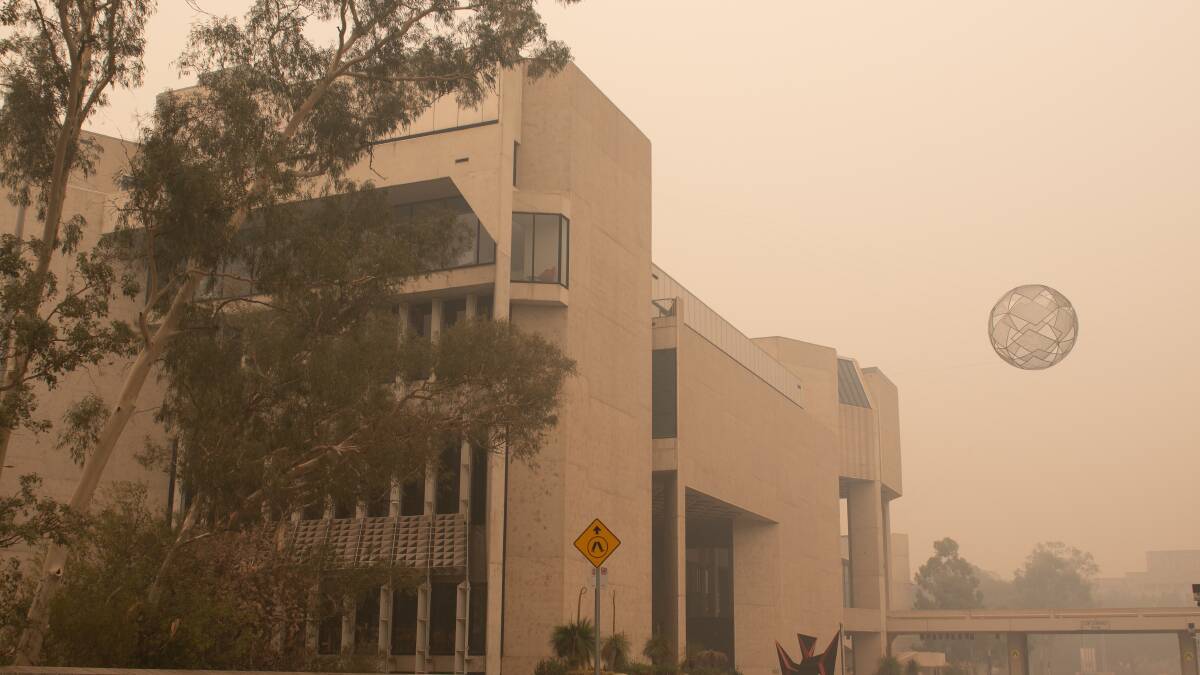
Smoke choked Canberra for weeks during the Black Summer bushfires. Picture: Elesa Kurtz
While the ACT saw a 26 per cent boost in GP visits during the week of December 22 last year, the following week at the height of the bushfire crisis on the South Coast saw a drop in appointments. The largest decreases were in the South Coast and Braidwood areas.
Chief executive of Asthma Australia Michele Goldman said more needed to be done in order to make places safer for people living with respiratory illnesses.
She said more severe cases of asthma and lung diseases were likely to surface in coming years.
“The fear is that exposure to smoke can cause existing conditions to worsen and it often causes new lung diseases to develop,” she said.
“Research needs to look at the exposure to different concentrations of smoke over time to see what it does to the airways.”
Even after the bushfires in the ACT stopped burning and the smoke subsided, Ms Connor said it took several weeks for her asthma symptoms to lessen.
“As soon as the air cleared, it wasn’t like things were immediately better, it can take a while to recover.”
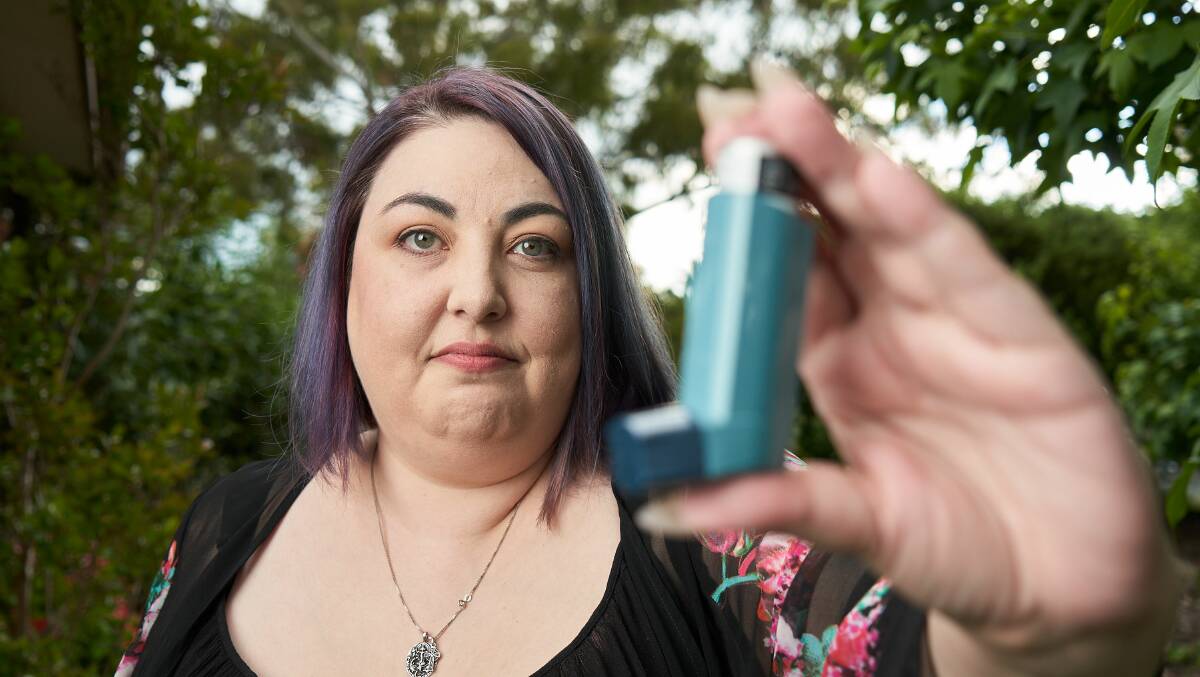
Kirsten Connor outside her home in Kaleen, where her asthma was badly impacted by bushfire smoke last year. Picture: Matt Loxton
Highway reopens after bushfire threat as more warm weather on the way
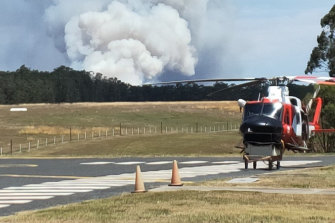
The Sydney Morning Herald reported that a bushfire raging in the state’s north was one of the first “watch and act” fires of the season, as hot and dry conditions are expected to elevate the fire danger further in the coming week.
The fire was burning in the Glenfield State Forest about 18 kilometres south-east of Grafton, alongside the Pacific Motorway, on Monday.
Smoke reduced visibility in the area and the highway was closed for several hours but reopened at 5.30pm.
The fire crossed the highway and homes near Franklin Road and Wells Crossing area were told to prepare their bushfire plans should they need to evacuate.
About 15 crews were in attendance and were supported by a firebombing aircraft. By 5pm, the fire was downgraded to “advice”.
Senior RFS spokesman Ben Shepherd said conditions were expected to ease in the evening, but could worsen later in the week.
The fire is one of 20 burning across the state, only seven of which are yet to be contained.
“Most of the coast has seen good rainfall, but areas in the top north of the state are not as fortunate,” he said. “This is one of the first hot and windy days of increasing fire activity.
Aussie Ark returns platypus to the wild after bushfire rescue
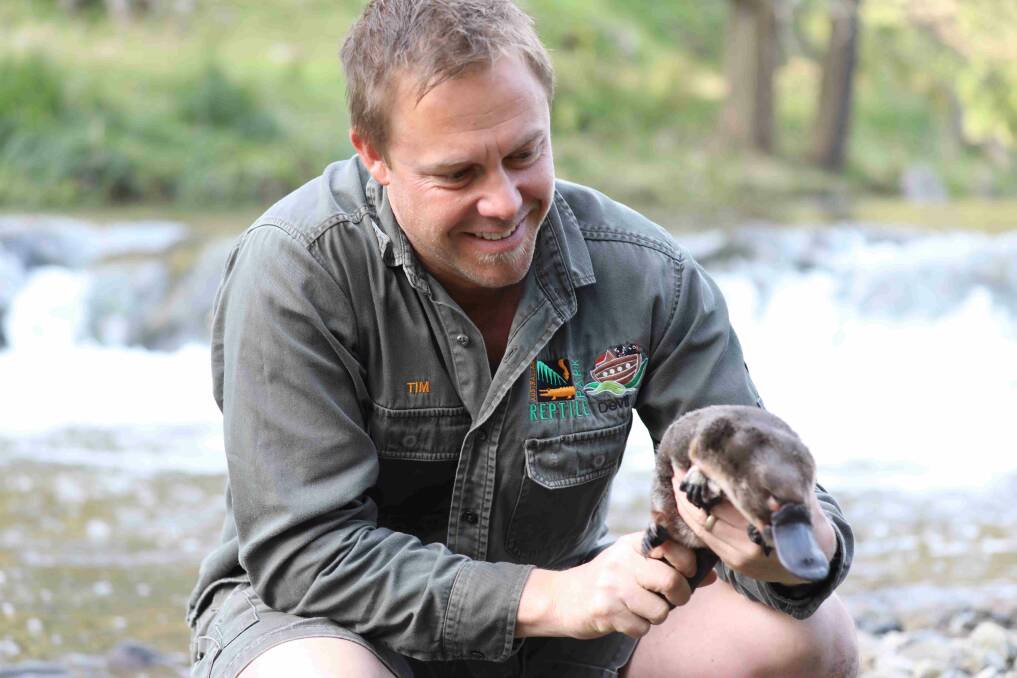
The Wingham Chronicle reported that five platypus rescued from certain death following drought and bushfire have been released back into the wild by Barrington Tops based wildlife conservation organisation Aussie Ark.
Waterways in the Hunter and Manning catchments were severely impacted by drought and fire; the Manning River stopped flowing for the first time in recorded history.
Following the bushfires Aussie Ark staff were in the field providing supplementary food sources, relocating animals and bringing into care those that needed veterinary attention.
Among the species rescued by Aussie Ark were the five platypus. The individuals were severely malnourished, and their pelts were showing signs of extreme distress. The animals were found in muddy pools of water no bigger than backyard swimming pools and were essentially swimming in their own faecal matter. They had little to no food available and rising water temperatures threatening their lives.
After being cared for at the Australian Reptile Park, the platypus have more than doubled in body weight and were ready to go home.
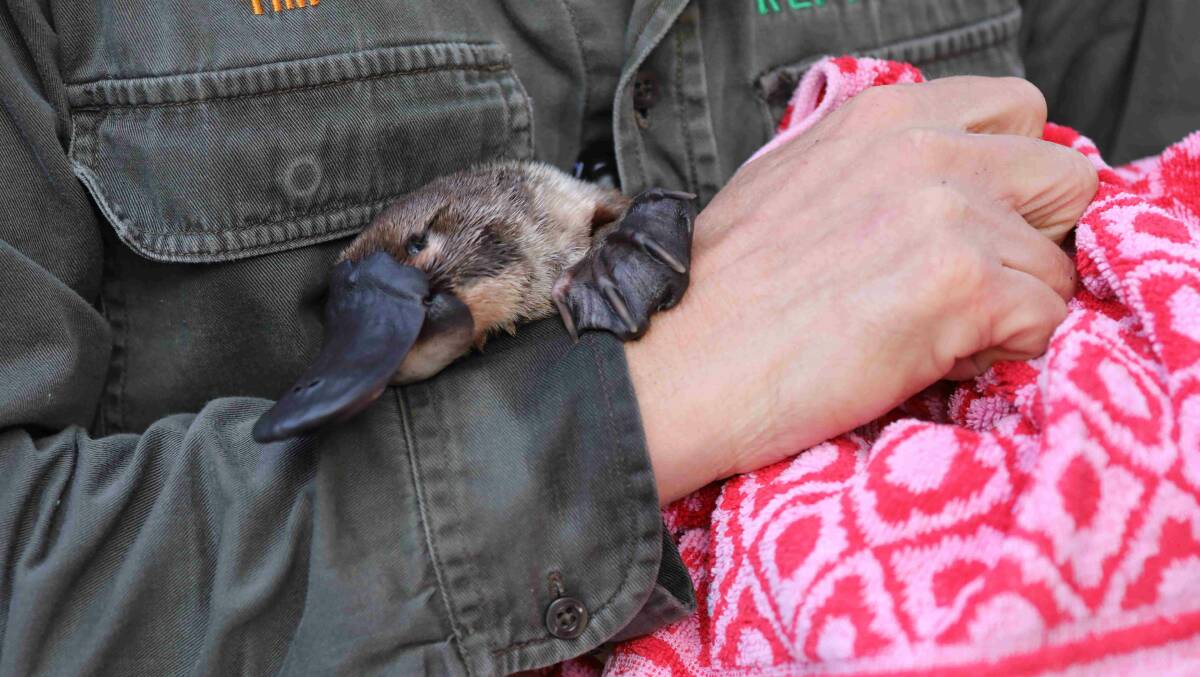
Photo: Aussie Ark
With the river systems now repairing due to rainfall, Aussie Ark has been out releasing the animals back into the waters they were rescued from. Each waterway the platypus was collected from has been carefully surveyed to establish water quality, abundance of food and disease in preparation for the release.
“It was heartbreaking to see our unique platypus suffering, they are such a beautiful species. They were swimming up and down the small water holes they still had left in search of food with nowhere else to go,” Aussie Ark president, Tim Faulkner said.
“Platypus are notoriously shy, and it is highly unusual for them to be so out in the open like they were, the fires would have driven them to do this.
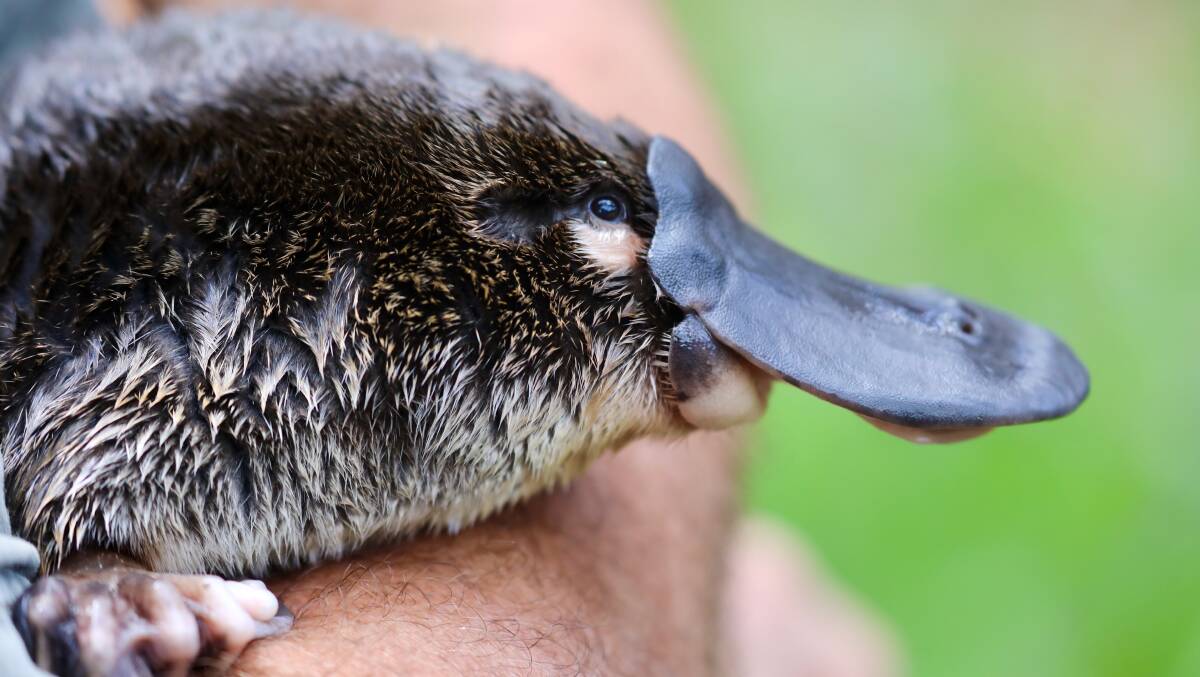
Photo: Aussie Ark
“This release is the moment we have worked for. These wacky creatures belong in the wild and that is exactly where we want to see them!
“Unfortunately, it is just not the case of releasing them back where they came from once the fires died down. Waterways suffer so much after fire, the ash, debris and silt run straight into our rivers, choking them. We needed to ensure that we were releasing them into an environment that was healthy and recovered” Mr Faulkner said.
Aussie Ark will continue to monitor the waterways to ensure the safety and wellbeing of the animals, and that no further intervention is needed.
In case of emergency: RFS and SES take part in preparedness planning
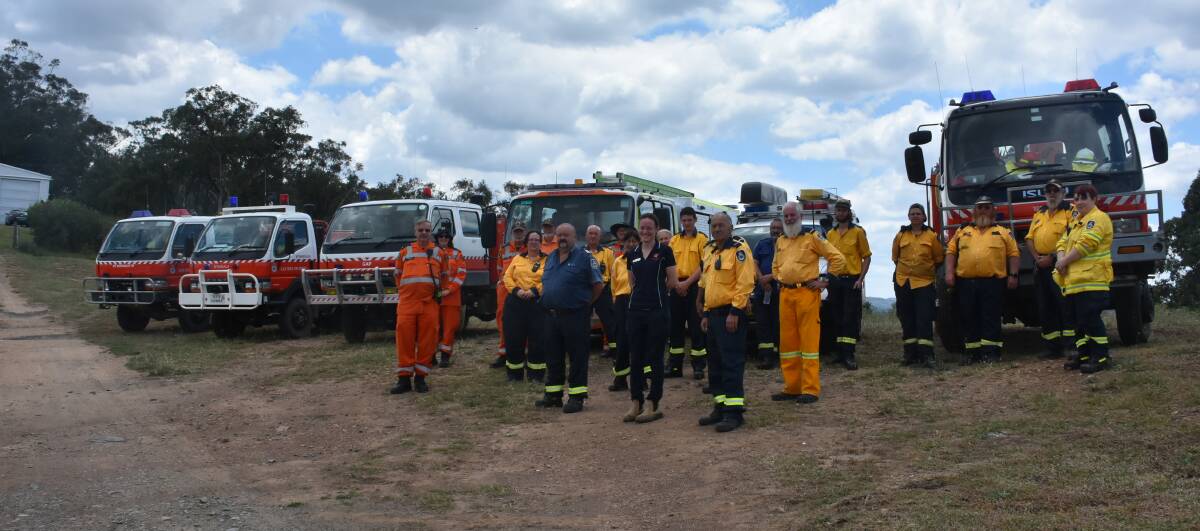
The Cowra Guardian reported that Mt McDonald, Woodstock, Lyndhurst and Gap RFS brigades alongside Cowra SES raced to Wyangala Waters on Wednesday and while there may have been smoke, there was no fire.
The units, alongside the park’s management and staff, were taking part in Exercise Reflections, a preparedness planning scenario involving the evacuation of the park.
The exercise bore fruit from the park’s annual fire and evacuation drill, with acting assistant manager, Jill Appleton, saying it was about being proactive rather than reactive.
“Particularly in light of last summer’s bushfires, and considering we’ve had a pretty good season this year, I thought it was a good opportunity to partner up with the SES and the local RFS to have an exercise,” she said.
“It’s an excellent opportunity and we’re very excited to have everyone involved and really grateful they’ve all given up time out of their day.
“They’ve had some new recruits for the RFS and we’ve had some new people come on board down at Reflections so it’s really good to be able to bring everyone together.”
Mt McDonald brigade captain, Paul Newman, said the exercise was a great training opportunity heading into the 2020/21 fire season.
“An inter-agency operation like this give us hands on experience for if something was to occur, how we would handle it and how the resources would work,” he said. “It makes sure the communications between the agencies works fine, communications back to headquarters and just the general scenario of how it runs and what needs to be done if it were to come real.”
Captain Newman said it was fantastic the park had allowed them to develop the scenario out of their annual drill.
“We’ve got other agencies involved and made it as real to life as what it could be so can iron out the bugs,” he said.
“If something goes wrong, we know what we’ve done wrong and it will be covered in the future.
“It also gives the community a sense of wellbeing to know that we are active and doing these exercises.
“We are an active area and we can represent and save the community if an incident does occur, whether it be fire or flood or storm damage, we have all avenues covered.”
Cowra SES Local Controller, Karl Milic, agreed, saying the closer to real life training was the better for all involved.
“We have trained evacuation personnel and this gives them a mock run through an evacuation exercise,” he said.
“Here we have a real life scenario for us to work through, It’s very important we try to make all our training as realistic as we can.
“If we can practice in real life scenarios then it’s best practice for us.”
He also praised the the RFS for inviting them to participate.
“With fires we only take part if we are asked but we’re an important back up for the RFS for administrative and logistics support,” he said.
“That is another reason why we need to work with the brigades in training which unfortunately doesn’t happen a lot.
“So this is really a good idea that the RFS guys here have had.
“I commend the RFS units in the area for trying to bring the emergency services to a closer working relationship.”
Hot, windy weekend ahead: RFS urges caution
The Forbes Advocate reported that the NSW Rural Fire Service is reminding those in the Forbes, Parkes, Weddin and Lachlan Shires of the risks associated with using vehicles and machinery around crop, pasture and stubble paddocks.
NSW RFS Superintendent Ken Neville said there has been a recent increase in the number of fires started by machinery in the local area.
They’re urging caution as the weekend forecast shapes up to deliver temperatures of up to 40 degrees and winds from the north.
“We are likely to see hot, dry and windy conditions over the coming Saturday and Sunday,” Superintendent Neville said.
“It only takes one spark to set off a serious fire that can quickly spread to adjoining paddocks and properties, potentially destroying valuable crops and farming land.”
If the weather acts as predicted, the NSW Rural Fire Service will likely be issuing a harvest alert for the weekend.
This would ask all those who are involved in harvest and other works to stop and check their local conditions before commencing.
The NSW Rural Fire Service Grain Harvesting Guide recommends that harvest operations cease when the Fire Danger Index (FDI) reaches or exceeds 35.
Harvest may recommence once the FDI falls below in the local area.
This can also be applied to non-harvest activities such as slashing and other earth works in paddocks.
“If fires start on these days they will be extremely difficult to control,” Supt Neville said.
“Vehicles and machines should be checked at regular intervals throughout the day and a water source or fire extinguisher must be carried to suppress any fire outbreaks.
“It is also important that farmers regularly take the time to clear grass and vegetation from machines and vehicles to reduce the chance of these fuels getting caught in the drive train or around the guards and mufflers.
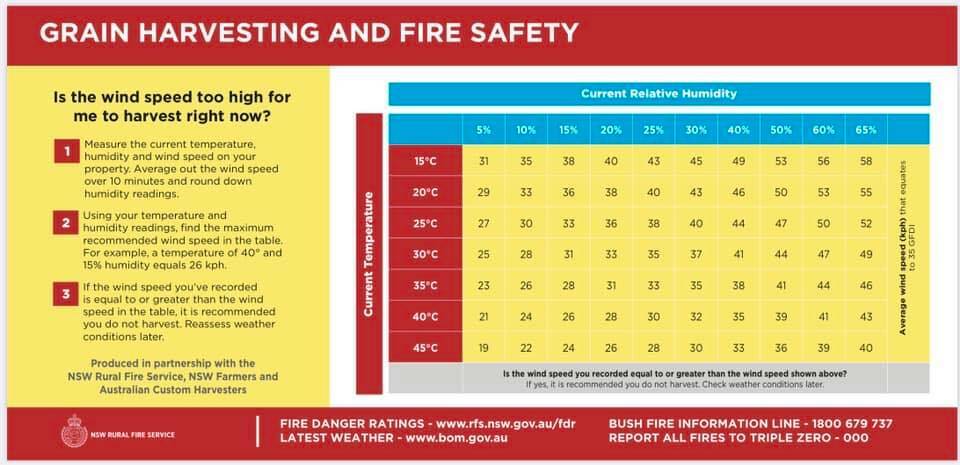
The Rural Fire Service is urging anyone harvesting or using machinery such as slashers to use the grain harvesting fire safety guide and monitor conditions.
“All machinery and vehicles must have an effective spark arrester fitted to the exhaust system to prevent fires.
“We recommend the drive train should be cleaned every two-to-three hours on days of increased fire danger.”
Supt. Neville said fire safety should be at the forefront of everyone’s mind at this time of year.
If the Fire Danger Rating (FDR) reaches Very High, all fire permits in the Forbes, Parkes, Lachlan and Weddin Shires will be suspended and a Total Fire Ban may also be issued.
“NSW RFS officers are available to provide advice on how to best protect a property during the fire season,” Supt. Neville said.
At time of preparing for press the temperature is forecast to peak at 37 degrees Friday, 40 Saturday, and again on Tuesday. Friday and Saturday we can expect northerly winds, increasing to 30km/hr on Saturday.
Maritime Union lends a helping hand to Nethercote RFS
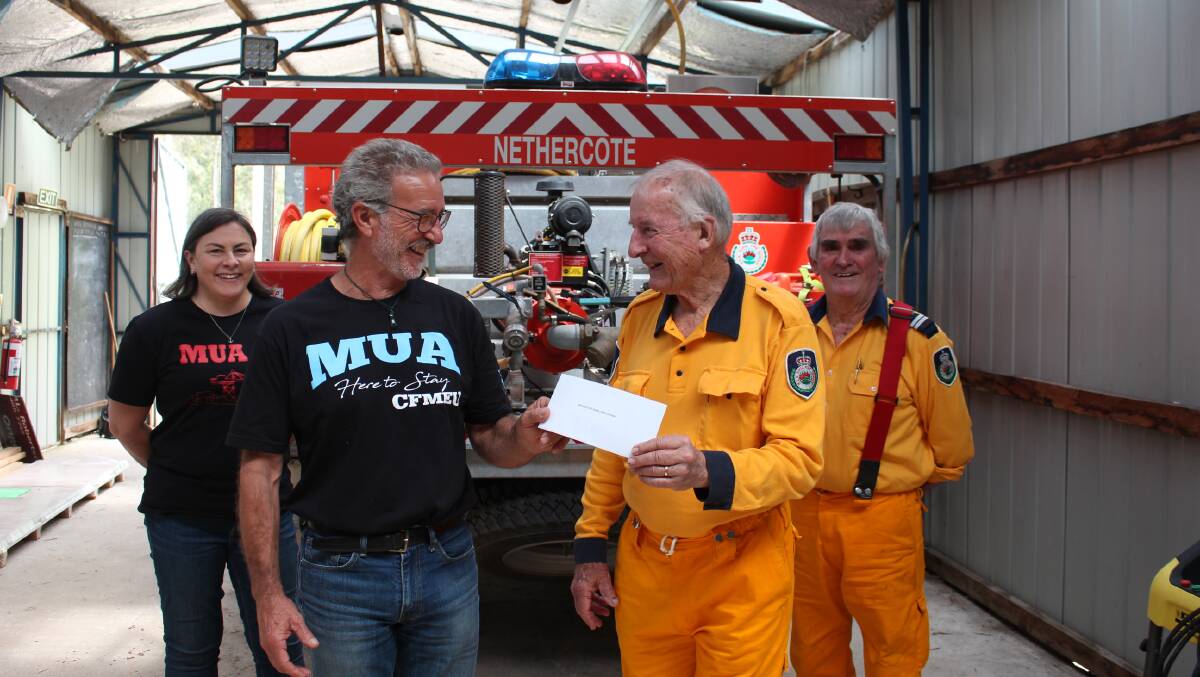
SMILES ALL ROUND: Nethercote Maritime Union of Australia member Brian Ahern hands the $5000 cheque from the MUA to Nethercote RFS treasurer Mike Lackey watched by MUA national officer Mich-Elle Myers and Nethercote RFS deputy captain Ray Robinson.
The Eden Magnet reported that Nethercote RFS treasurer Mike Lackey said you could have knocked him down with a feather when he received the phone call about a donation to the brigade.
The $5000 donation from the Maritime Union of Australia (MUA) is not only very welcome and timely but also the largest non-government donation the rural brigade has ever received.
It comes at a time when the membership has been expanding following last summer’s bushfires and the recent theft of valuable radio equipment, a chainsaw and defibrillator.
National officer with the MUA Mich-Elle Myers said when the bushfires happened they had members from all over the world contacting the head office and asking how they could help.
“People from the US, the UK and Norway – they alone put in $35,000 – put in huge amounts of money,” Ms Myers said.
“We helped a couple of our members who lost their homes and now we’re distributing the rest of the money.”
With a focus on helping areas which have a seafaring connection, Ms Myers asked members where their help was needed. MUA member Brian Ahern, who works on the tug boats at Eden, mentioned the theft at Nethercote RFS and it was decided to be a most appropriate use of a donation.
“Mich asked me if I knew of anyone in need and I said these guys have had a really rough trot and lost so much,” Mr Ahern said.
“We had $16,000 worth of radio equipment, portable radios and PMR radio which connects us to Sydney, stolen plus a chainsaw and defibrillator,” Mr Lackey said.
He said there most people who die on the fire ground were older fire fighters who died of a heart attack and so having a defibrillator on board the truck was really important.
There had been $1000 given to the brigade earlier this year which had been raised from a special bushfire music night at the Nethercote Hall at which Mr Ahern was one of the organisers. The money was used in the provision of some portable radios which were then stolen.
Interestingly the the main radio which was stolen, had a locator built in Mr Lackey said, and the RFS head office was waiting for it to be used.
“The RFS knew it had been used once and then it went off the air,” Mr Lackey said.
There is speculation that whoever stole the equipment may have done so to order and knew what they were doing, subsequently deactivating any technology which might give clues to the equipment’s location.
The MUA’s $5000 donation will be used to help finish off fitting out the new kitchen/training extension.
The MUA has also donated $3000 to Eden Marine High School towards new laptops for students.
Bonny Hills RFS receives grant to invest in training
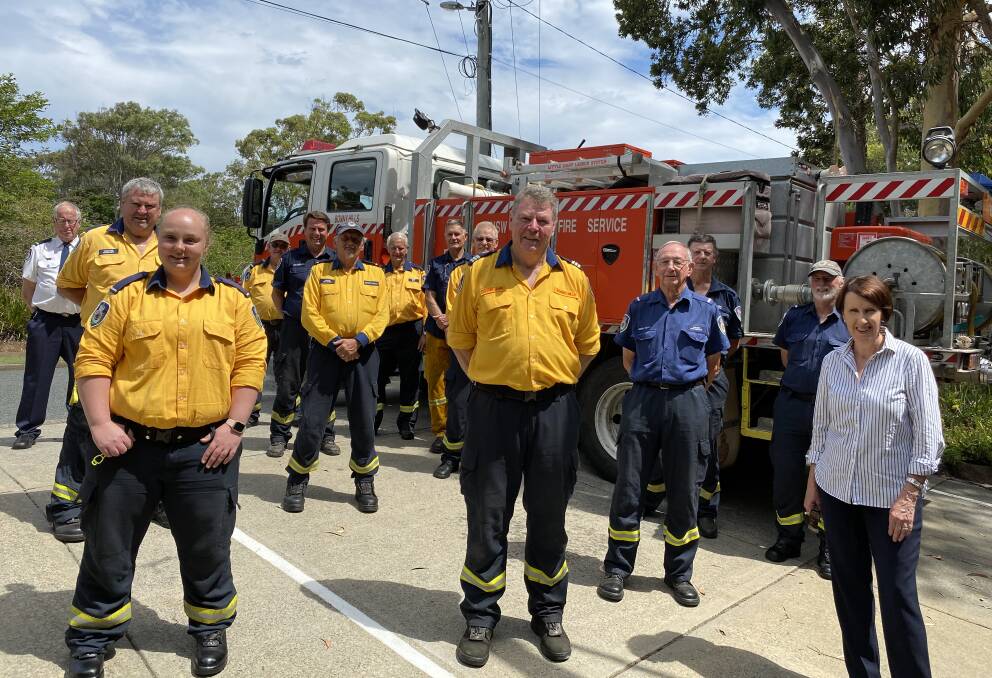
Funds boost: Members of the Bonny Hills Rural Fire Brigade with Port Macquarie MP Leslie Williams.
The Camden Courier reported that the electorate of Port Macquarie has secured almost $300,000 in funding for a total of 18 projects through the NSW Government’s 2020 Community Building Partnership Program.
Member for Port Macquarie, Leslie Williams said the funds will deliver much-needed improvements to local facilities including the Bonny Hills Rural Fire Brigade who have received $20,000 to extend their training and meeting room.
“This is fantastic news. This grassroots funding will directly help create a more vibrant and inclusive local community with positive social, environmental and recreational outcomes,” Mrs Williams said.
“I congratulate all the organisations that were successful in their application and look forward to seeing how these projects make a real difference for community groups in the area.”
Other successful projects in the Camden Haven for the 2020 round are:
- $23,291 to Creek to Creek Queens Lake Trail to repair an existing footbridge, improve drainage and upgrade public walkways.
- $10,620 to Laurieton Public School P C Association to purchase external storage facilities.
- $13,583 to Hannam Vale Public School P C Association to improve their kitchen and upgrade the garden.
Green Gully fire demonstrates danger of hot weather, thunderstorms
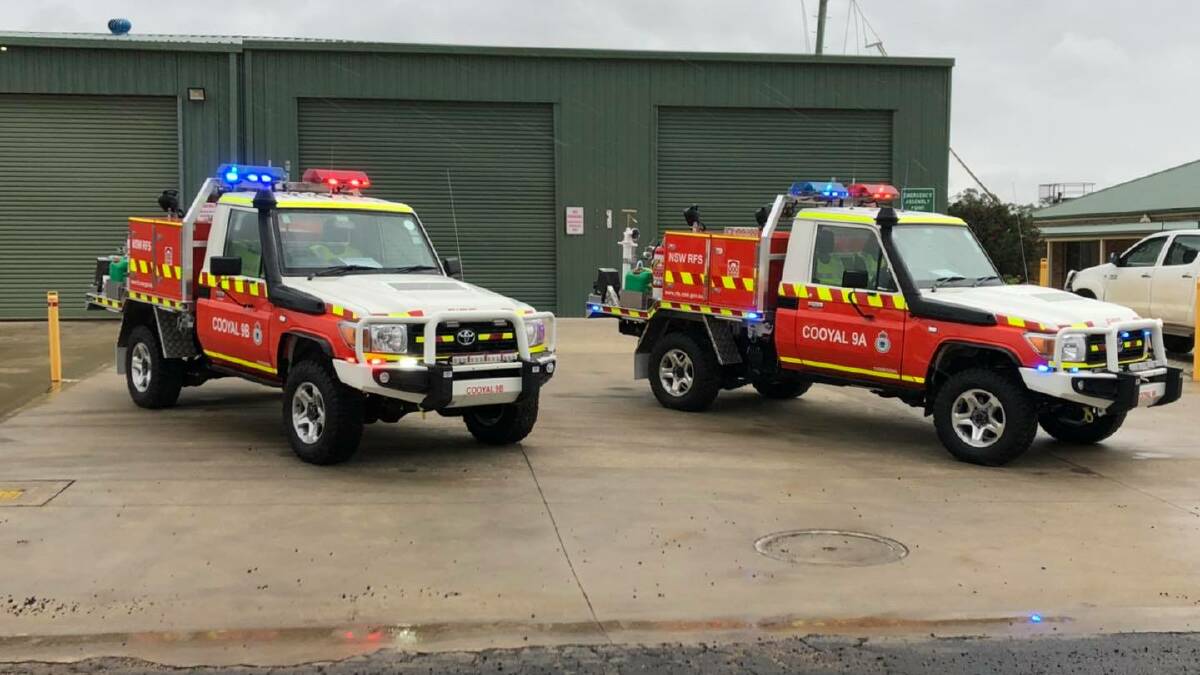
The Mudgee Guardian reported that two brand new Category 9 (ultra light) firefighting appliances were assigned to the Cooyal Brigade this week, perfect timing with temperatures forecast to nudge 40 degrees this coming weekend. Photo: NSW RFS – Cudgegong District.
The first local blaze of the bushfire danger period – at Green Gully last weekend – was a reminder that there is a real fire threat in the Mid-Western Region, despite the cool weather and frequent rain throughout Spring.
“Unlike a year ago, when tinder-dry conditions made bush fires the major threat, our primary concern this year is the risk of grass fires. These fires are potentially deadly because they burn so hot and can spread much faster than a bush fire,” said Superintendent Troy Porter of the NSW Rural Fire Service Cudgegong District.
“That doesn’t mean we can discount the threat of bush fires. In fact, Cudgegong District volunteers were called out this past weekend to battle a bush fire believed to have been started by lightning in a steep, heavily timbered gully behind homes on Green Gully Road.”
The Green Gully fire was particularly difficult to contain because steep terrain made the site inaccessible to tankers. Crews supported by effective helicopter water-bombing had to walk in to the site and use hand tools to chop a containment line one metre wide around the fire.
Despite the rugged conditions, fire fighters were able by Sunday night to contain the blaze to just over half a hectare. No homes were threatened.
“This fire illustrates two things,” Supt Porter said.
“First, although grass fires are our major concern this year, we can’t discount the threat posed by bush fires. And second, although the wet weather and the land burnt last year have reduced this year’s bush fire threat there is still a lot of unburnt timber in the bush and our spring rains have added new growth to bushland fuel loads.
“I’d like to urge residents across our Region make sure their families and their properties are prepared for this Bush Fire Danger Period. Four simple steps are all it takes [BELOW].
“If you, your home and your family are prepared you stand a better chance of surviving a bushfire. By visiting rfs.nsw.gov.au/plan-and-prepare you can find checklists to help with the four ‘get ready’ steps as well as a wealth of other fire safety information.”
The four steps to prepare this fire season
- Discuss what to do if a bushfire threatens your home. Having this discussion over dinner can be good because your family is assembled and focused. Ask how fireproof your plan is and what you can do to make it better. Ensure everyone understands what to do.
- Prepare your home and get it ready for the bush fire season. Keep the grass cut low around your house and remove any debris near the house. Make sure your gutters are clean and you have enough hose to stretch around your house.
- Know the bush fire alert levels. If there is a fire in your area you will find its alert level on the NSW RFS website and in the ‘Fires Near Me’ app. You need to keep track of the alert level so you know what you should do.
- Keep all of your key bush fire information ready to access. This information ranges from the Triple Zero (000) emergency reporting line to the NSW RFS website, the ‘Fires Near Me’ app, the facebook.com/nswrfs and twitter.com/nswrfs addresses and news media such as local radio, local ABC radio, local TV and local newspaper addresses.
There’s an upgraded app for that

The Emergency Plus app.
The Cudgegong RFS District is encouraging locals to download the Emergency Plus app, which helps emergency services find you after calling Triple Zero (000).
The free app now features @what3words, so callers can describe their exact location in an emergency, quickly and easily, with three words. Along with street address and GPS coordinates.
Every three-metres-square in the world has been given a what3words address so you can alert emergency services with a unique three-word combination.
Download the free emergency app at the Apple App Store and the Google Play Store.

If you’d like to nominagte someone for a RFS INternal Service Award you can do so using this form.
RFS Captain Darcy McCann recognised for efforts during Gospers Mountain bushfire
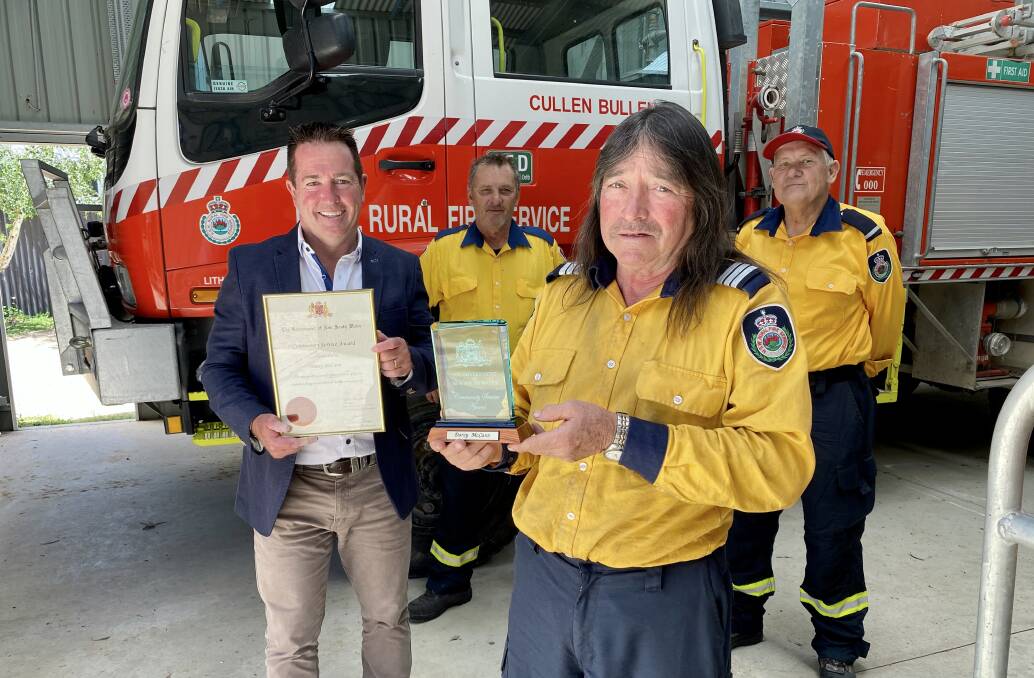
COMMUNITY SERVICE AWARD: Cullen Bullen RFS Captain Darcy McCann receives his Community Service Award from Member for Bathurst Paul Toole. Also pictured are John McCann and Les Ayres, far right. Photo: SUPPLIED
The Lithgow Mercutry reported that the extraordinary efforts of Rural Fire Service volunteer Darcy McCann in going above and beyond the call of duty have been recognised by Member for Bathurst Paul Toole.
Mr Toole presented Mr McCann, the captain of the RFS Cullen Bullen Brigade, with a NSW Government Community Service Award for his role in helping protect the community during the devastating summer bushfires of 2019-20.
He received a specially made plaque and framed certificate signed by Premier Gladys Berejiklian to mark this important occasion.
Mr McCann recalled how Cullen Bullen had been evacuated as the fire came raging towards the town.
“We thought everything was going to be lost … and I mean everything,” Mr McCann said.
“However, a change in wind direction saw the fire go back on itself and by some sort of miracle it turned around and went the other way.ADVERTISING
“All our volunteers are champions, just the best team of people you could imagine. They do what they do because we are all about community here at Cullen Bullen. That’s what is so special about this place.”
Mr Toole said Mr McCann and the members of his brigade are unsung heroes to their community.
“Darcy accepted the award on behalf of everyone in his crew,” Mr Toole said.
“In fact, residents from Cullen Bullen were so appreciative of their RFS heroes they gathered to thank their local brigade for their bravery when defending the area from bushfires.
“A special dinner was organised by the local Progress Association earlier this year where the community united as one to say thank you to the volunteers for going above and beyond the call of duty.”
Captain Darcy McCann and his troops were given a standing ovation as their efforts were officially acknowledged by guests including Bathurst MP Paul Toole and Lithgow councillor Maree Statham.
“The community just wanted to do something to say thank you to these special people who put their lives on the line for not only their local community, but in other areas too,” Mr Toole said.
At the time Cullen Bullen Progress Association president Agnes Tilley presented a special certificate of recognition to Captain McCann who was clearly humbled by all the fuss.
Carwoola bushfire class action lawyers call for more affected people to join sui
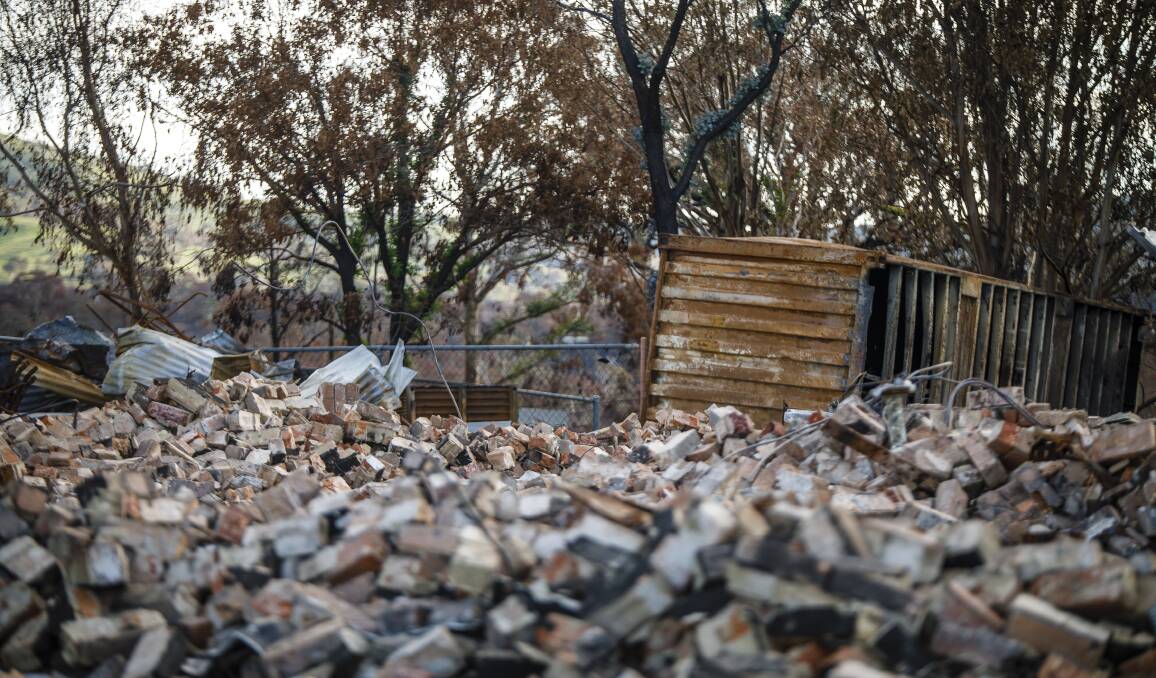
The Canberra Tines reported that eleven homes were destroyed and more properties damaged in the 2017 Carwoola bushfire.
A class action against an insurance giant following the devastating Carwoola bushfires in 2017 has progressed with lawyers calling on anyone impacted to join the suit.
A group of about 70 residents and landowners have registered with Maddens Lawyers to progress a class action against CGU Insurance Australia.
Maddens Lawyers principal Kathryn Emeny said there were important developments occurring in the class action which meant it was a good time for people to register their interest if they had not already done so.
“In the coming weeks there will be experts in the Carwoola area meeting with members of the class action to assist them in recording and quantifying the loss and damage they suffered as a result of the fire,” Ms Emeny said.
“This is a really important step for each group member in advancing their claim.
“We are aware there are others that were impacted by the fire but have not yet been in contact with us. I’d encourage those people to act promptly and let us know of their circumstances.”
Maddens Lawyers were given the green light to start the case in August last year when the NSW Supreme Court found against CGU, who had denied all liability.
The fire, which began when a plumbing company employee used steel cutting equipment during a total fire ban and sparks ignited nearby grass, burned about 3500 hectares and destroyed 11 homes.
‘We thought the fire would skirt around the town’: 175 NSW schools at high risk during bushfires
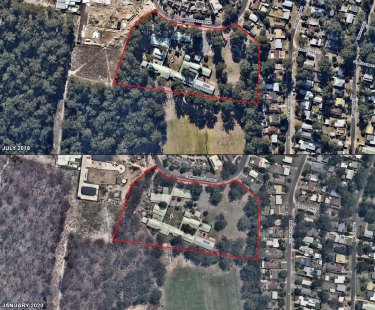
The Sydney Morning Herald reported that an audit of NSW public schools in bushfire-affected areas has found more than half face a medium or high risk in a future fire.
The NSW Department of Education audit used NSW Rural Fire Service mapping to classify 175 government-owned school sites as high risk. The analysis covered areas across regional NSW and greater Sydney, including Asquith, Pennant Hills, Wahroonga and Frenchs Forest.
About 195 schools were considered medium risk, including some of the areas worst hit by last summer’s catastrophic blazes, from the Mid North Coast to Batemans Bay.
The results have been used to inform which schools require the greatest bushfire hazard reduction works, such as vegetation maintenance and asset protection zones, which were credited with saving sites such as Broulee Public School at the height of the bushfire crisis in January.Advertisement
Broulee principal Matthew Rose said flames came as close as 1.5 metres from classrooms at the South Coast school, but the only structure lost was a shed.
Mr Rose credits the lack of damage to vegetation clearing almost four months earlier, which left a 70-metre protection zone around the school hall.
“We thought the fire would probably skirt around the town, the area, and we would be protected,” Mr Rose said. Instead, he was forced to respond to an emergency alert to evacuate his nearby Malua Bay home on New Year’s Eve and head straight to the beach.
It was only after the firestorm hit that day that he heard “a whisper that a school in Broulee had been burnt”.
“To be honest, I thought it might have been one of the private schools there, rather than mine,” he said.
Mr Rose said he found the western edge of the school “totally devastated”, including the shed that had been storing the school’s mower, shade shelters and mulchers.
“The area that had been mitigated was the area most substantially hit. If it hadn’t been for the asset protection zone we definitely would have lost more buildings,” he said.
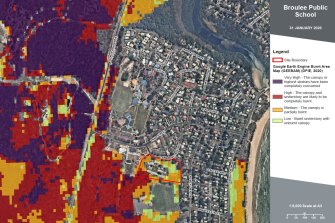
“I don’t think there is any doubt [the protection zone] took so much heat out of the fire which was so hot it melted electrical cables in the ground.”
Around 32 of the school’s 360 students were directly impacted by the fire, with 21 students losing their homes. Under the recent audit, Broulee Public School was deemed to be of medium risk in a bushfire.
NSW Education Minister Sarah Mitchell said preparations were well underway at public schools ahead of this year’s bushfire season, informed by the findings of the risk audit.
She said annual audits and vegetation management programs “undoubtedly saved schools in last summer’s fires”.
“As well as being important educational assets, in times of crisis our schools are centres for the community,” she said, pointing to Eden Marine High School, which was used by the Australian Defence Force last year as an accommodation and operations centre.
The audit found 258 schools presented a low risk, 84 a very low risk, while 34 exhibited no risk at all. The audit surveyed 712 schools.
RFS spokesman Ben Shepherd said because schools catered for children, “our most vulnerable”, it was vital they maintained bushfire action plans as well as their land. “By and large you will find most of them do that and do it very well,” he said.
Since 2013 the Department of Education has engaged Aboriginal social enterprise Muru Mittigar to undertake asset protection zone and bushfire vegetation maintenance works at nominated bushfire-affected school sites.
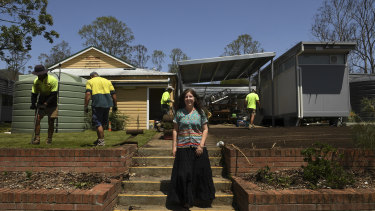
The strategy has included skills training and employment opportunities for Aboriginal people across NSW.
An Aboriginal cultural burn pilot program is also being trialled next winter, which will combine cultural burning practices with non-Aboriginal land management on public school land.
During the 2019-20 bushfires one school was destroyed, and one significantly damaged – Bobin Public School on the NSW Mid North Coast and Wytaliba Public School on the Northern Tablelands.

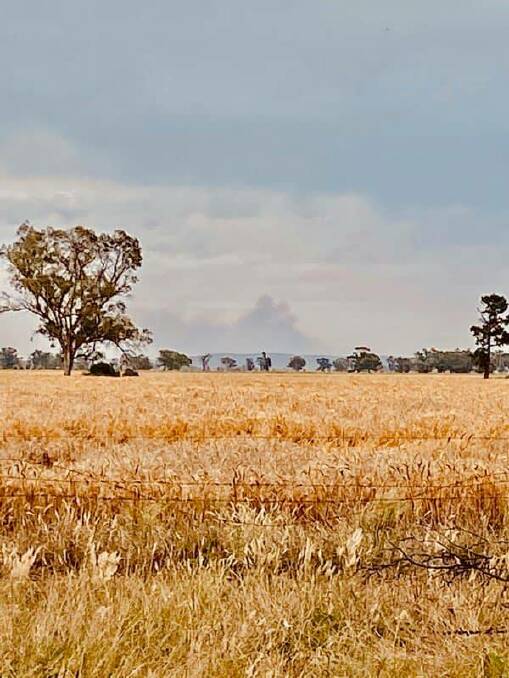
Fraser Island needed burning. It will need another fire in 10 years. and 10 years after that.